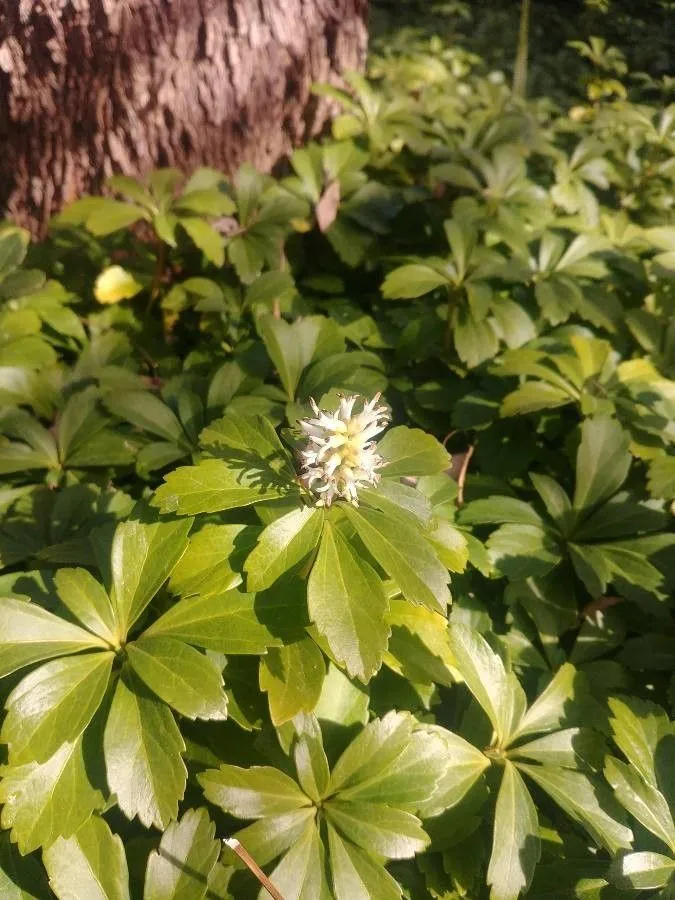
Author: Siebold & Zucc.
Bibliography: Abh. Math.-Phys. Cl. Königl. Bayer. Akad. Wiss. 4(2): 142 (1845)
Year: 1845
Status: accepted
Rank: species
Genus: Pachysandra
Vegetable: False
Observations: C. & E. China, S. Sakhalin to Japan
Japanese pachysandra, botanically known as Pachysandra terminalis, is a popular evergreen ground cover plant widely appreciated for its robust nature and attractive foliage. It was first described in scientific literature in the mid-19th century by Siebold & Zucc., and has since become a staple in many shaded gardens and landscaped environments. This plant belongs to the Buxaceae family, which includes several other notable species often used in horticulture.
Native to regions spanning from central and eastern China to southern Sakhalin and Japan, Japanese pachysandra thrives in environments that mimic its natural habitat. It is well-adapted to shaded or partially shaded areas, flourishing under the canopy of larger trees and in other low-light conditions where many other plants might struggle. The plant forms dense mats of glossy green leaves, which not only provide attractive ground coverage but also help suppress weed growth effectively.
This evergreen species exhibits leathery, dark green leaves that are typically ovate to obovate in shape with serrated edges, which maintain their vibrant color year-round. In the spring, Japanese pachysandra produces small, white, fragrant flowers that, while not particularly showy, add a subtle charm to the plant’s overall appearance. These flowers are usually arranged in terminal spikes, contributing to the plant’s botanical name, terminalis.
Due to its low maintenance requirements and its ability to thrive in shaded areas with minimal sunlight, Japanese pachysandra is particularly favored by gardeners and landscape architects for ground cover purposes. It is a resilient plant that, once established, requires little additional care. However, it is important to ensure that the soil is well-drained yet remains consistently moist to keep the roots healthy.
Moreover, Japanese pachysandra is known for its ability to withstand various climatic conditions, making it a versatile choice for a wide range of environments. Its resilience against pests and diseases further contributes to its popularity as a garden staple.
In summary, Japanese pachysandra is an invaluable plant for those seeking to create lush, green carpets in shaded garden spaces. Its ease of care, attractive evergreen foliage, and modest flowers make it an ideal choice for both amateur gardeners and professional landscapers alike.
Eng: carpet box, carpet-box, japanese pachysandra, japanese mountain spurge, japanese-spurge, japanese spurge
Deu: japanischer ysander
Dan: vinterglans
Swe: skuggröna, skugg-gröna
Nld: dikkemanskruid, pachysandra
Fra: pachysandre à épis terminaux
Nob: vinterglans
Nno: vinterglans
Cym: pren bocs carped
En: Japanese pachysandra, Carpet-box, Japanese-spurge, Pachusandra, Japanese mountain-spurge, Pachysandra, Carpet Box, Japanese mountain spurge, Japanese spurge
Da: Vinterglans
Nl: Dikkemanskruid, Pachysandra
Fr: Pachysandre à épis terminaux
De: Japanischer Ysander, Dickmännchen, Ysander
Nb: Vinterglans
Nn: Vinterglans
Sv: Skuggröna, Skugg-gröna
Cy: Pren Bocs Carped
© copyright of the Board of Trustees of the Royal Botanic Gardens, Kew.
© copyright of the Board of Trustees of the Royal Botanic Gardens, Kew.
© copyright of the Board of Trustees of the Royal Botanic Gardens, Kew.
Taken Mar 15, 2011 by Photoflora – Benoit BOCK (©)
Taken Aug 22, 2021 by High Treeson (cc-by-sa)
Taken Mar 20, 2022 by huy HO (cc-by-sa)
Taken Jan 3, 2022 by Jim Knopf (cc-by-sa)
Taken Jan 3, 2022 by Jim Knopf (cc-by-sa)
Taken Apr 5, 2021 by Dieter Wagner (cc-by-sa)
Taken Nov 10, 2021 by Fabrice Rubio (cc-by-sa)
Taken Jan 10, 2021 by Dieter Wagner (cc-by-sa)
Taken Feb 21, 2020 by erinnide (cc-by-sa)
Taken Sep 24, 2015 by Tela Botanica − Frédéric CROCHET (cc-by-sa)
Taken Apr 10, 2009 by Tela Botanica − Yoan MARTIN (cc-by-sa)
Taken May 7, 2020 by Julia Basun (cc-by-sa)
Taken Mar 2, 2020 by Kerstin Kerstin (cc-by-sa)
Taken Jul 27, 2019 by Sabina Hartmann (cc-by-sa)
Taken Mar 15, 2021 by Emiko Iizuka (cc-by-sa)
Taken Nov 13, 2022 by jesse jolling (cc-by-sa)
Taken Nov 15, 2021 by Ziske Frank (cc-by-sa)
Taken Oct 27, 2021 by Annemarie Ahrens-Stehle (cc-by-sa)
Taken Mar 2, 2020 by Kerstin Kerstin (cc-by-sa)
Taken Apr 11, 2021 by from NL HK (cc-by-sa)
Taken Sep 7, 2022 by Simone Pippig (cc-by-sa)
Taken Mar 6, 2021 by R Jessie (cc-by-sa)
Taken Oct 23, 2022 by Colin McKevitt (cc-by-sa)
Taken Dec 10, 2020 by Anthony Casalino (cc-by-sa)
Taken Jan 10, 2021 by Dieter Wagner (cc-by-sa)
Taken Mar 31, 2020 by Jorge Pina (cc-by-sa)
Taken Mar 20, 2022 by huy HO (cc-by-sa)
Taken Oct 23, 2022 by Colin McKevitt (cc-by-sa)
Taken May 29, 2021 by William Kraus (cc-by-sa)
Taken Jul 30, 2019 by Farrington Ryan (cc-by-sa)
Growth form: Rhizomatous
Growth habit: Forb/herb, Subshrub
Growth rate: Slow
Ph maximum: 7.5
Ph minimum: 5.5
Family: Myrtaceae Author: (F.Muell.) K.D.Hill & L.A.S.Johnson Bibliography: Telopea 6: 402 (1995) Year: 1995 Status:…
Family: Rubiaceae Author: Pierre ex A.Froehner Bibliography: Notizbl. Bot. Gart. Berlin-Dahlem 1: 237 (1897) Year:…
Family: Sapindaceae Author: Koidz. Bibliography: J. Coll. Sci. Imp. Univ. Tokyo 32(1): 38 (1911) Year:…
Family: Asteraceae Author: A.Gray Bibliography: Pacif. Railr. Rep.: 107 (1857) Year: 1857 Status: accepted Rank:…
Family: Fabaceae Author: Medik. Bibliography: Vorles. Churpfälz. Phys.-Ökon. Ges. 2: 398 (1787) Year: 1787 Status:…
Family: Aspleniaceae Author: (Cav.) Alston Bibliography: Bull. Misc. Inform. Kew 1932: 309 (1932) Year: 1932…